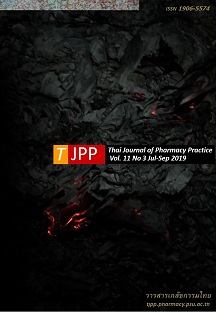การพัฒนาเครื่องมือวัดความแตกฉานด้านสุขภาพของคนไทย ที่อิงการวัดความสามารถในการใช้ฉลากโภชนาการ
Main Article Content
บทคัดย่อ
วัตถุประสงค์: เพื่อพัฒนาและทดสอบแบบคัดกรองความแตกฉานด้านสุขภาพ (health literacy: HL) ของชาวไทยที่ใช้ฉลากโภชนาการในการทดสอบหรือ Thai Health Literacy Assessment Instrument: Nutrition label (THLA-N ) และหาเกณฑ์แปลผลคะแนนที่วัดได้ วิธีการ: THLA-N ถูกพัฒนาให้ประเมิน HL โดยใช้คำถาม 7 ข้อที่วัดความสามารถในการใช้ฉลากโภชนาการในลักษณะเดียวกับแบบวัด Newest Vital Sign และคำถาม 3 ข้อสำหรับคัดกรอง HL ผู้เชี่ยวชาญ 5 ท่าน (นักวิจัยในเรื่องการสร้างเครื่องมือวัดและประเมินผล แพทย์ เภสัชกร พยาบาล และเจ้าหน้าที่สาธารณสุข) ประเมินความตรงเชิงผิวหน้าของแบบวัด หลังจากนั้น แบบวัดถูกทดสอบเพื่อค้นหาความเข้าใจผิดที่อาจเกิดขึ้นโดยใช้เทคนิคการคิดออกเสียง (think aloud) ในบุคคลทั่วไปที่มีการศึกษาระดับต่าง ๆ 15 ราย ต่อมาผู้วิจัยทดสอบนำร่องแบบวัดฉบับแก้ไขในผู้ป่วยนอก 30 ราย และทดสอบในผู้ป่วยนอก 497 รายในโรงพยาบาลศูนย์แห่งหนึ่งตามลำดับ การทดสอบความตรงทำโดยหาความแตกต่างของ THLA-N ระหว่างผู้ที่มีการศึกษาระดับต่าง ๆ และการหาความสัมพันธ์ระหว่าง THLA-N กับความสามารถในการอ่านและความสามารถในการเข้าใจเอกสารสุขภาพ การหาเกณฑ์แปลผลคะแนนใช้การวิเคราะห์โค้ง ROC (receiver operating curve) โดยใช้ผลรวมของคะแนนความสามารถในการอ่านและความสามารถในการเข้าใจเอกสารสุขภาพเป็นตัววัดมาตรฐานตัวที่ 1 (gold standard 1: GS1) และความสามารถในการเข้าใจเอกสารสุขภาพเป็นตัววัดมาตรฐานตัวที่ 2 (GS2) ผลการวิจัย: คำถาม 2 ข้อใน THLA-N มีผู้ตอบถูกน้อยกว่าร้อยละ 5 จึงถูกตัดออกจากแบบวัด คะแนนที่คำนวณจากคำถาม 8 ข้อ เรียกว่า THLA-N8 แบบวัด 8 ข้อมีความเที่ยง 0.70 แบบวัดมีความตรงโดยผู้ที่มีระดับการศึกษาสูงกว่า มีคะแนน THLA-N8 มากกว่าผู้ที่มีระดับการศึกษาต่ำกว่า (P<0.001) THLA-N8 มีค่าสหสัมพันธ์ทางบวกและมีนัยสำคัญทางสถิติกับ 2 ตัวชี้วัดของ HL คือ ความเข้าใจในเอกสารสุขภาพ และความสามารถในการอ่าน (r=0.48 และ 0.21 ตามลำดับ) ในการวิเคราะห์โค้ง ROC แบบวัด THLA-N8 มีพื้นที่ใต้โค้งที่ 0.76 และ 0.81 เมื่อใช้ GS1 และ GS2 เป็นตัววัดมาตรฐาน ตามลำดับ ซึ่งบ่งชี้ว่า แบบวัดสามารถแยกแยะผู้ที่มี HL ที่เพียงพอและไม่เพียงพอได้ดี คะแนน THLA-N8 ที่น้อยกว่าหรือเท่ากับ 4.83 บ่งบอก HL ที่ไม่เพียงพอ แบบวัดมีความไว 0.71 และ 0.75 เมื่อใช้ GS1 และ GS2 เป็นตัววัดมาตรฐาน ตามลำดับ ความจำเพาะของแบบวัดมีค่า 0.67 และ 0.73 เมื่อใช้ GS1 และ GS2 เป็นตัววัดมาตรฐาน ตามลำดับ สรุป: แบบวัด THLA-N8 มีความเที่ยง ความตรง ความไว และความจำเพาะอยู่ในระดับที่น่าพอใจ อย่างไรก็ตามควรมีการศึกษาในตัวอย่างกลุ่มอื่นเพื่อยืนยันคุณสมบัติการวัดทางจิตวิทยาและเกณฑ์แปลผลคะแนนต่อไป
Article Details
ผลการวิจัยและความคิดเห็นที่ปรากฏในบทความถือเป็นความคิดเห็นและอยู่ในความรับผิดชอบของผู้นิพนธ์ มิใช่ความเห็นหรือความรับผิดชอบของกองบรรณาธิการ หรือคณะเภสัชศาสตร์ มหาวิทยาลัยสงขลานครินทร์ ทั้งนี้ไม่รวมความผิดพลาดอันเกิดจากการพิมพ์ บทความที่ได้รับการเผยแพร่โดยวารสารเภสัชกรรมไทยถือเป็นสิทธิ์ของวารสารฯ
เอกสารอ้างอิง
2. Berkman ND, Sheridan SL, Donahue KE, Halpern DJ, Viera A, Crotty K, et al. Health literacy interventions and outcomes: an updated systematic review. Evid Rep Technol Assess 2011; 199:1-941.
3. 3. Berkman ND, Sheridan SL, Donahue KE, Halpern DJ, Crotty K. Low health literacy and health outcomes: an updated systematic review. Ann Intern Med. 2011; 155: 97-107.
4. Cho YI, Lee SY, Arozullah AM, Crittenden KS. Effects of health literacy on health status and health service utilization amongst the elderly. Soc Sci Med 2008, 66: 1809–16.
5. Nguyen TH, Paasche-Orlow MK, Kim MT, Han HR, Chan KS. Modern measurement approaches to health literacy scale development and refinement: overview, current uses, and next steps. J Health Commun. 2015;20 Suppl 2:112-5.
6. Davis TC, Crouch M, Wills G, Abdehou D. Rapid assessment of literacy levels of adult primary care patients. Fam Med 1991; 23:433-55.
7. Parker RM, Baker DW, Williams MV, Nurss JR. The test of functional health literacy in adults: a new instrument for measuring patients’ literacy skills. J Gen Intern Med 1995; 10:537-41.
8. Weiss BD, Mays MZ, Martz W, Casto KM, DeWalt DA, Pignone MP, et al. Quick assessment of literacy in primary care: the Newest Vital Sign. Ann Fam Med 2005; 3: 514-22.
9. Duell P, Wright D, Renzaho AMN, Bhattacharya D. Optimal health literacy measurement for the clinical setting: A systematic review. Patient Educ Couns 2015; 98: 1295–307.
10. Health Education Division, Department of Health Service Support, Ministry of Public Health. Strate- gies for health literacy development to modify 5 unhealthy behaviors (eating, exercise, emotion, smoking and drinking) and reduce health risk. Nonthaburi: Ministry of Public Health, 2013.
11. Tanasugarn C, Neelapaichit N. Scale for health literacy in patients with diabetes and hypertension [online]. 2015 [cited Jan 20, 2018]. Available from: www.nkp-hospital.go.th/th/H.ed/mFile/20180122115 054.pdf
12. Kaewsomboom T. Participatory learning strategy to promote health literacy of pre-invasive cervical carcinoma patient [master thesis]. Bangkok: Mahi- dol University; 2008.
13. Nomsiri A, Srisiri S, Virutsetazin K, Malarat A. Development of sexual health literacy indicators for early adolescent. Thammasat Medical Journal 2015 ; 5: 609-21.
14. Inkaew A, Traiwichitkhu D. The development of health literacy tool for students. Online Journal of Education 2015; 10: 262-73.
15.Jindawong B. Development of health literacy screen ing tools for patients at Srinagarind Hospital, Khon Kaen, Thailand, Faculty of Medicine, Khon Kaen University [master thesis]. Khon Kaen: Khon Kaen University; 2013.
16. Nutbeam D. Health promotion glossary. Health Promot Int 1998, 13: 349-64.
17.Nukeaw P. Knowledge on nutrition label among consumers in Rattaphum District, Songkla Province [independent study]. Songkhla: Prince of Songkla University; 2004.
18. Chew LD, Bradley K A, Boyko EJ. Brief questions to identify patients with inadequate health literacy. Fam Med 2004; 36: 588–94.
19. Willis GB, Royston P, Bercini D. The use of verbal report methods in the development and testing of survey questionnaires. Appl Cognit Psychol 1991; 5: 251–67.
20.Faul GF, Erdfelder E, Buchner A and Lang AG. Statistical power analyses using G*Power 3.1: tests for correlation and regression analyses. Behav Res Methods 2009; 41: 1149-60.
21. Baker DW, Williams MV, Parker RM, Gazmararian JA, Nurss J. Development of a brief test to measure functional health literacy. Patient Educ Couns 1999; 38: 33-42.
22. Jittangwong J, Lerkiatbundit S, Kaewnopparat N. Measuring errors in pediatric liquid medication among caregivers: magnitudes and related factors. Thai Journal of Pharmacy Practice 2018; 10: 477-93.
23. Howell DC. Statistical methods for psychology. Bel mont, CA: Thomson Wadsworth, 2010.
24. Youden WJ. Index for rating diagnostic tests. Cancer 1950; 3: 32–5.
25. Zhou XH, Obuchowski NA, Obushcowski DM. Statistical methods in diagnostic medicine. New York: Wiley & Sons; 2002.
26. Swets JA. Measuring the accuracy of diagnostic systems. Science 1988; 240:1285-93.
27. Fransen MP, Van Schaik TM, Twickler TB, Essink-Bot ML. Applicability of internationally available health literacy measures in the Netherlands. J Health Commun. 2011; 16 Suppl 3:134-49.
28. Sahm LJ, Wolf MS, Curtis LM et al. Prevalence of limited health literacy among Irish adults. J Health Commun 2012; 17, Suppl. 3, 100–8.
29. Ozdemir H, Alper Z, Uncu Y et al. Health literacy among adults: a study from Turkey. Health Educ Res 2010; 25, 464–77.
30. Kogure T, Sumitani M, Suka M et al. Validity and reliability of the Japanese version of the Newest Vital Sign: a preliminary study. PLoS One 2014; 9, e94582.
31. Weiss BD, Mays MZ, Martz W, Casto KM, DeWalt DA, Pignone MP, et al. Quick assessment of literacy in primary care: the Newest Vital Sign. Ann Fam Med 2005;3: 514-22.
32. Manganello JA: Health literacy and adolescents: a framework and agenda for future research. Health Educ Res 2008, 23: 840-7.
33. Nunnally JC, Bernstein IH. Psychometric theory. New York: McGraw-Hill Education; 1994.
34. Osborn CY, Weiss BD, Davis TC, Skripkauskas S, Rodrigue C, Bass PF, et al. Measuring adult literacy in health care: performance of the Newest Vital Sign. Am J Health Behav 2007;31(Suppl 1):S36-46.


